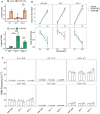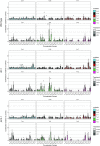Resistance of mitochondrial DNA to cadmium and Aflatoxin B1 damage-induced germline mutation accumulation in C. elegans
- PMID: 35947695
- PMCID: PMC9410910
- DOI: 10.1093/nar/gkac666
Resistance of mitochondrial DNA to cadmium and Aflatoxin B1 damage-induced germline mutation accumulation in C. elegans
Abstract
Mitochondrial DNA (mtDNA) is prone to mutation in aging and over evolutionary time, yet the processes that regulate the accumulation of de novo mtDNA mutations and modulate mtDNA heteroplasmy are not fully elucidated. Mitochondria lack certain DNA repair processes, which could contribute to polymerase error-induced mutations and increase susceptibility to chemical-induced mtDNA mutagenesis. We conducted error-corrected, ultra-sensitive Duplex Sequencing to investigate the effects of two known nuclear genome mutagens, cadmium and Aflatoxin B1, on germline mtDNA mutagenesis in Caenorhabditis elegans. Detection of thousands of mtDNA mutations revealed pervasive heteroplasmy in C. elegans and that mtDNA mutagenesis is dominated by C:G → A:T mutations generally attributed to oxidative damage. However, there was no effect of either exposure on mtDNA mutation frequency, spectrum, or trinucleotide context signature despite a significant increase in nuclear mutation rate after aflatoxin B1 exposure. Mitophagy-deficient mutants pink-1 and dct-1 accumulated significantly higher levels of mtDNA damage compared to wild-type C. elegans after exposures. However, there were only small differences in mtDNA mutation frequency, spectrum, or trinucleotide context signature compared to wild-type after 3050 generations, across all treatments. These findings suggest mitochondria harbor additional previously uncharacterized mechanisms that regulate mtDNA mutational processes across generations.
© The Author(s) 2022. Published by Oxford University Press on behalf of Nucleic Acids Research.
Figures





Similar articles
-
Exposure to mitochondrial genotoxins and dopaminergic neurodegeneration in Caenorhabditis elegans.PLoS One. 2014 Dec 8;9(12):e114459. doi: 10.1371/journal.pone.0114459. eCollection 2014. PLoS One. 2014. PMID: 25486066 Free PMC article.
-
Mitochondrial mutations in Caenorhabditis elegans show signatures of oxidative damage and an AT-bias.Genetics. 2021 Oct 2;219(2):iyab116. doi: 10.1093/genetics/iyab116. Genetics. 2021. PMID: 34849888 Free PMC article.
-
Mitochondrial Mutation Rate, Spectrum and Heteroplasmy in Caenorhabditis elegans Spontaneous Mutation Accumulation Lines of Differing Population Size.Mol Biol Evol. 2017 Jun 1;34(6):1319-1334. doi: 10.1093/molbev/msx051. Mol Biol Evol. 2017. PMID: 28087770 Free PMC article.
-
Mitochondrial DNA Mutagenesis: Feature of and Biomarker for Environmental Exposures and Aging.Curr Environ Health Rep. 2021 Dec;8(4):294-308. doi: 10.1007/s40572-021-00329-1. Epub 2021 Nov 11. Curr Environ Health Rep. 2021. PMID: 34761353 Free PMC article. Review.
-
Analysis of mutational signatures in C. elegans: Implications for cancer genome analysis.DNA Repair (Amst). 2020 Nov;95:102957. doi: 10.1016/j.dnarep.2020.102957. Epub 2020 Aug 28. DNA Repair (Amst). 2020. PMID: 32980770 Review.
Cited by
-
Key Amino Acid Residues of Mitochondrial Transcription Factor A Synergize with Abasic (AP) Site Dynamics To Facilitate AP-Lyase Reactions.ACS Chem Biol. 2023 May 19;18(5):1168-1179. doi: 10.1021/acschembio.3c00047. Epub 2023 Mar 17. ACS Chem Biol. 2023. PMID: 36930463 Free PMC article.
-
DNA repair pathways in the mitochondria.DNA Repair (Amst). 2025 Feb;146:103814. doi: 10.1016/j.dnarep.2025.103814. Epub 2025 Feb 1. DNA Repair (Amst). 2025. PMID: 39914164 Review.
-
Assessment of developmental neurotoxicology-associated alterations in neuronal architecture and function using Caenorhabditis elegans.bioRxiv [Preprint]. 2025 Jan 14:2025.01.11.632560. doi: 10.1101/2025.01.11.632560. bioRxiv. 2025. Update in: ALTEX. 2025 Apr 23. doi: 10.14573/altex.2501151. PMID: 39868199 Free PMC article. Updated. Preprint.
-
Programmed mitophagy at the oocyte-to-zygote transition promotes species immortality.Res Sq [Preprint]. 2025 Apr 9:rs.3.rs-6330979. doi: 10.21203/rs.3.rs-6330979/v1. Res Sq. 2025. PMID: 40297685 Free PMC article. Preprint.
-
Dual chemical labeling enables nucleotide-resolution mapping of DNA abasic sites and common alkylation damage in human mitochondrial DNA.Nucleic Acids Res. 2023 Jul 21;51(13):e73. doi: 10.1093/nar/gkad502. Nucleic Acids Res. 2023. PMID: 37293974 Free PMC article.
References
-
- Johnston I.G., Williams B.P.. Evolutionary inference across eukaryotes identifies specific pressures favoring mitochondrial gene retention. Cell Syst. 2016; 2:101–111. - PubMed
-
- Tuppen H.A.L., Blakely E.L., Turnbull D.M., Taylor R.W.. Mitochondrial DNA mutations and human disease. BBA - Bioenerg. 2009; 1797:113–128. - PubMed
Publication types
MeSH terms
Substances
Grants and funding
LinkOut - more resources
Full Text Sources
Research Materials

